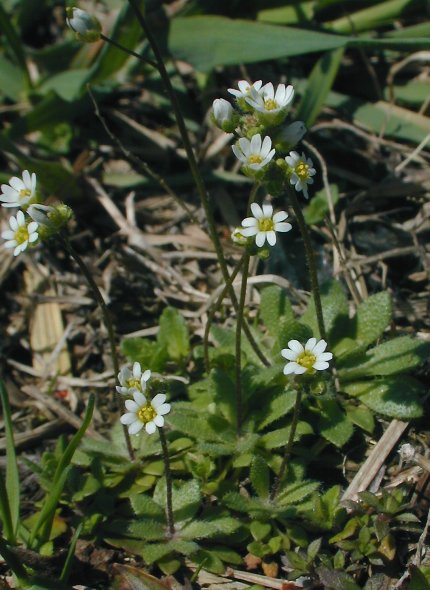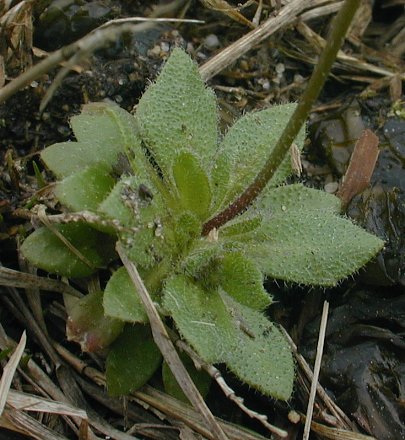Description: This plant is a winter annual, consisting of a small rosette of basal leaves and one or more flowering stems that are 1-5" tall. The basal leaves are up to 1" long and ¼" across. They are oblong or oblanceolate, somewhat hairy, and smooth along the margins. The flowering stems are leafless and usually hairless, terminating in a small raceme of flowers. Each flower is about 1/8" (3 mm.) across, consisting of 4 white petals, 4 green sepals, 6 stamens with yellow anthers, and a single pistil. Each petal is deeply cleft. The blooming period occurs intermittently from early to mid-spring and lasts about 3-4 weeks. The seedpods are oblong, flattened, and hairless, tapering to curved blunt tips. In the typical variety of this species, each seedpod is more than twice as long as wide and contains more than 40 seeds. In the less common var. praecox, each seedpod is less than twice as long as wide and contains fewer than 40 seeds. The seedpods of both varieties are shorter than the pedicels. The root system consists of shallow fibrous roots. This plant spreads by reseeding itself and it often forms colonies of varying size.

Cultivation:
The
preference is full sun, mesic to dry conditions, and a sterile soil
containing too much sand, clay, or gravel. This plant completes its
development during the spring and withers away by summer.
Range & Habitat:
Early Whitlow Grass is occasional to locally common in most areas of
Illinois, except for the western and NW areas of the state, where it is
rare or absent (see Distribution
Map). This non-native plant is adventive from Eurasia.
Habitats include fields, pastures, sandy nursery plots, gravelly areas
along railroads and roadsides, bare patches of lawns, edges of trampled
paths, and sterile waste areas with little vegetation. This species
occurs in areas with a history of disturbance.
Faunal Associations:
According to Müller (1873/1883), the flowers attract Halictid or
Andrenid bees, which suck nectar. Where large colonies occur, the
flowers may attract honeybees, which collect pollen. Visitors to the
flowers are uncommon, however, because of their early bloom. Rabbits
may nibble on the leaves during the spring, otherwise this plant has
little value to mammalian herbivores or birds.

Photographic
Location:
Along a path at the Champaign County Fairgrounds in Urbana, Illinois.
This plant also occurs along railroads in the area, sometimes in great
abundance.
Comments:
Early Whitlow Grass (Draba
verna) is one of the earliest annual plants to bloom
during the spring. The flowers open up when the weather is warm and
sunny, otherwise they remain closed. In dry sterile areas, blooming
plants may be only 1-2" tall (including the flowering stems). The
flowers are rather showy, considering the small size of the plant.
Early Whitlow Grass is easy to identify because it is the only Whitlow
Grass (Draba sp.)
in Illinois with deeply notched petals. Other species of
Whitlow Grass are short-lived perennials that produce white flowers
with unnotched petals.
Their flowering stems usually have a few leaves, while the stems of
Early Whitlow Grass are leafless. Another scientific name of Early
Whitlow Grass is Erophila
verna. The common name "Whitlow
Grass" is a misnomer because these species are members of the Mustard
family (Brassicaceae), rather than the Grass family (Poaceae).